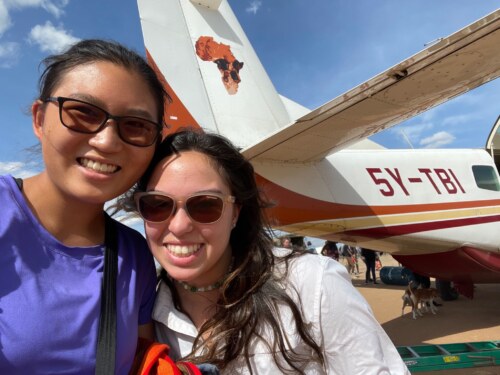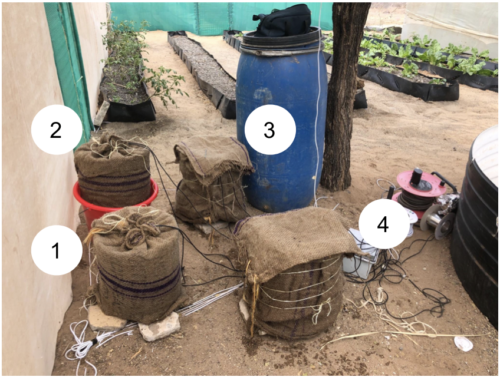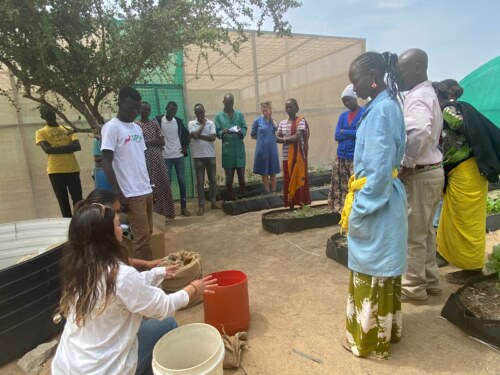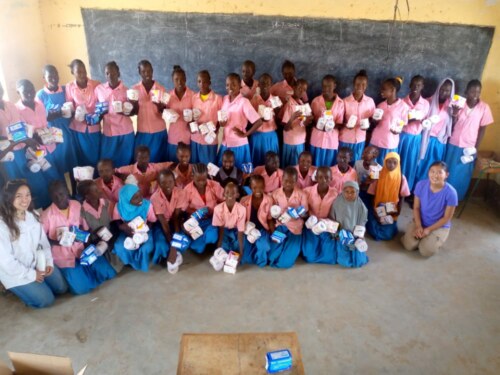Hi again! It’s Ava and Christine, Mechnical Engineering Undergraduate students from MIT D-Lab.
After a beautiful few days spotting animals in the Masai Mara, we flew up to TBI’s facility on the east side of Lake Turkana in Ileret to continue our evaporative cooling research! During our time in Ileret, we focused on understanding the local context and engaging with the community who our technology will potentially impact. While running a few experiments at TBI, we were also able to explore the village and meet some people around Ileret.

Christine and Ava arriving in Ileret, its is really remote and easiest to get to by plane. TBI’s Air Turkana helps support research in the region.
As a reminder, our research is focused on designing and optimizing the efficiency of evaporative coolers for fruit and vegetable preservation to increase access to fresh produce and reduce spoilage. We are using sensors to test the temperature and humidity inside various designs that we come up with. For our experiments in Ileret, we focused on the jerry can design because it is low cost and easy to make using locally available materials!
This design consists of 1-2 jute sacks wrapped around a jerry can with the top cut off. The jerry can acts as the structural container for the produce, and the fiber sacks absorb the water which evaporates and cools off the container throughout the day. We tested four slightly different designs – all focused on using the jute sack without cutting it, so that it can still be used as a sack in the future.

Several jerry can coolers, these are all slightly different, and we collected data on the performance of each. 1. Jute sack sewn snuggly around a jerry can with drawstring to tie the top together.2. Same as #1, but placed inside a bucket filled with water to test whether or not the jute sack wicks water throughout the day.
3. Jute sack folded around a jerry can, secured with string. A jute sack cover is placed on top. 4. Same as #3, but using a square jerry can instead of a circular one.
In addition to testing our evaporative coolers, we also placed sensors around the hydroponic farm to help TBI collect data for the hydroponics program! Temperature and humidity sensors were placed at different locations and heights to gain more insight into how the structure of the farm impacts the growing conditions.
Demonstration with Hydroponics Trainees
TBI also runs a hydroponics training program, where Ileret community members learn to run their own hydroponic farms. Since there is no farming and extremely limited access to fruits and vegetables in Ileret and the surrounding area, hydroponic farming is a potential way to provide nutritious foods to a community in an arid region. The trainees regularly take home produce from the farm, so during our time in Ileret, we had the opportunity to demonstrate our jerrycan evaporative coolers to the hydroponics trainees and discuss how they can help keep their produce fresher for longer periods of time.

Demonstrating the jerrycan coolers to the hydroponic agriculture trainees.
We received feedback from the trainees and had a longer discussion about the usefulness, feasibility, and accessibility of the materials required. The trainees shared that jerrycans are widely accessible, but jute sacks are not commonly used or available in Ileret. Thus going forward, part of our research will involve looking for alternate absorbent materials that can be used or discussing how jute sacks can be distributed to people interested in making their own evaporative cooler. Another limitation in Ileret is fresh water; therefore, we will also be researching how brackish water impacts the efficiency of evaporative cooling. The trainees were excited about the possibility of using evaporative cooling, which was very exciting on our end as well!
When we first came to TBI, we had no idea how much our research would intersect with some of TBI’s programming, so it’s been awesome to see how we can collaborate and work together to address sustainability issues and food insecurity in this region.
Community engagement
Since our research involves working with the local communities, a portion of our time in Ileret was also dedicated to learning more about the Daasanach community and culture. Joanne, TBI’s Community Development Manager, showed us around Ileret and introduced us to healthcare workers, school children, and other community members! We toured the local healthcare facility and learned more about the outreach programs that address food insecurity and child malnourishment.
We also had the opportunity to meet young girls at the local school and hand out sanitary pads. Without proper sanitary pads, girls are unable to attend school when they are menstruating, so TBI donates products to girls in the community to promote education. The opportunity to meet community members and learn more about Ileret was a crucial component to our research. As engineers, it is important to understand people’s goals, challenges, and lifestyle in order to design technology that will properly address community needs.

We got to meet school girls and give out sanitary supplies. These are critical for keeping girls in school.
Continuing our research in Ileret was an amazing experience – the people were super friendly, the lake was beautiful, and our data showed promising results for the jerry can evaporative cooling design!
Authored by Ava Dijstelbloem and Christine Tang.





